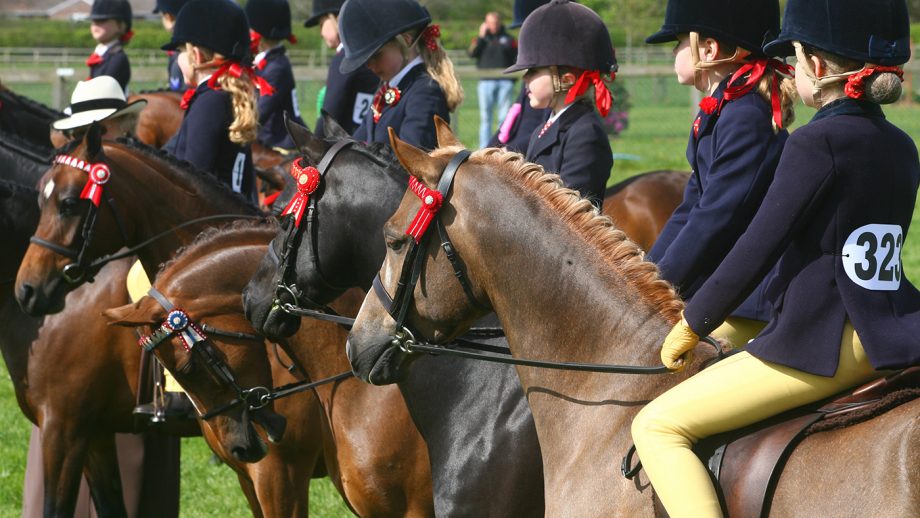Some of the world’s best jockeys, eventers, showjumpers and dressage riders started their equestrian careers in the show ring. Tricia Johnson finds out why it’s the perfect foundation...
Over the years, the show ring has been the launchpad of many stellar careers in other disciplines. Sometimes, the “new” careers might seem far removed, but many aspects of that showing experience have proved the ideal grounding for young talent.
Top jump jockey Nico de Boinville showed ponies as a child, and his successes began with winning the SEIB Search For A Star final at Horse Of The Year Show (HOYS) in 1998 on Barkway Black Magic. His racing CV now includes three Queen Mother Champion Chase wins – two on Altior and one on Sprinter Sacre – and a Cheltenham Gold Cup victory on Coneygree; he has ridden more than 350 winners.
{"content":"PHA+4oCcQmVpbmcgc3ViamVjdGVkIHRvIGEgY29tcGV0aXRpdmUgYXRtb3NwaGVyZSBmcm9tIGEgeW91bmcgYWdlIGhhcyBtb3N0IGRlZmluaXRlbHkgaGVscGVkIG1lLOKAnSBzYXlzIE5pY28sIHdobyB3YXMgdHJhaW5lZCBmb3IgdGhlIHNob3cgcmluZyBieSBSaWNoYXJkIGFuZCBNYXJqb3JpZSBSYW1zYXkuIOKAnFNob3dpbmcgZXhwb3NlcyB5b3UgdG8gZGVhbGluZyB3aXRoIHByZXNzdXJpc2VkIGVudmlyb25tZW50cyDigJMgcGFydGljdWxhcmx5IGF0IHRoZSBiaWdnZXIgZXZlbnRzIHN1Y2ggYXMgdW5kZXIgdGhlIGxpZ2h0cyBhdCBIT1lTLiBZb3UgaGF2ZSB0byBiZSBhYmxlIHRvIHBlcmZvcm0gdW5kZXIgcHJlc3N1cmUgYXMgaWYgaXQgaXNu4oCZdCB0aGVyZSwgYW5kIHRoaXMgaXMgZXNzZW50aWFsIGluIHJhY2luZzsgZXZlcnkgZGF5IEkgYW0gcHV0dGluZyBpbnRvIHByYWN0aWNlIGxlc3NvbnMgdGhhdCBJIGxlYXJuZWQgd2hlbiBJIHdhcyBzaG93aW5nLuKAnTwvcD4KPHA+RmVsbG93IGpvY2tleSBOaWNrIFNjaG9sZmllbGQgbWFkZSBhIHNpbWlsYXIgc3dpdGNoLCBiZWdpbm5pbmcgb24gdGhlIGxlYWQtcmVpbiBhbmQgcHJvZ3Jlc3NpbmcgdG8gbGFuZGluZyB0aGUgcG9ueSBzdXByZW1lIGF0IEhPWVMgaW4gMjAwNCBvbiBDaGlkZG9jayBPdmVyIFRoZSBMaW1pdCwgcHJvZHVjZWQgYnkgVGVhbSBUaG9tYXMuIE5pY2sgd2FzIGFsc28gc2hvdyBwb255IGNoYW1waW9uIGF0IHRoZSBSb3lhbCBJbnRlcm5hdGlvbmFsIChSSUhTKSB3aXRoIFBvc2ggU3BpY2UsIGFuZCBoaXMgcmFjaW5nIGZvcm0gaW5jbHVkZXMgdHdvIHZpY3RvcmllcyBhdCB0aGUgQ2hlbHRlbmhhbSBGZXN0aXZhbCBhbmQgZm91ciBHcmFkZSBPbmUgcmFjZXMuPC9wPgo8cD7igJxJbiBzaG93aW5nLCB5b3Ugb25seSBoYXZlIG9uZSBzaG90IGF0IHlvdXIgY2xhc3Mg4oCTIGFzIHlvdSBkbyBpbiBhIHJhY2Ug4oCTIGFuZCB0aGF0IGV4cGVyaWVuY2UgaXMgYSBib251cyBub3cs4oCdIGhlIHNheXMuIOKAnEkgd2FzIGFsc28gbHVja3kgdG8gcmlkZSBmb3Igb3duZXJzIHdoZW4gSSB3YXMgeW91bmcsIHdoaWNoIHByZXBhcmVkIG1lIGZvciByaWRpbmcgZm9yIOKAkyBhbmQgY29tbXVuaWNhdGluZyB3aXRoIOKAkyBwZW9wbGUgdGhyb3VnaG91dCBteSByYWNpbmcgY2FyZWVyLuKAnTwvcD4KPHA+PGRpdiBjbGFzcz0iYWQtY29udGFpbmVyIGFkLWNvbnRhaW5lci0tbW9iaWxlIj48ZGl2IGlkPSJwb3N0LWlubGluZS0yIiBjbGFzcz0iaXBjLWFkdmVydCI+PC9kaXY+PC9kaXY+PHNlY3Rpb24gaWQ9ImVtYmVkX2NvZGUtMzEiIGNsYXNzPSJoaWRkZW4tbWQgaGlkZGVuLWxnIHMtY29udGFpbmVyIHN0aWNreS1hbmNob3IgaGlkZS13aWRnZXQtdGl0bGUgd2lkZ2V0X2VtYmVkX2NvZGUgcHJlbWl1bV9pbmxpbmVfMiI+PHNlY3Rpb24gY2xhc3M9InMtY29udGFpbmVyIGxpc3RpbmctLXNpbmdsZSBsaXN0aW5nLS1zaW5nbGUtc2hhcmV0aHJvdWdoIGltYWdlLWFzcGVjdC1sYW5kc2NhcGUgZGVmYXVsdCBzaGFyZXRocm91Z2gtYWQgc2hhcmV0aHJvdWdoLWFkLWhpZGRlbiI+DQogIDxkaXYgY2xhc3M9InMtY29udGFpbmVyX19pbm5lciI+DQogICAgPHVsPg0KICAgICAgPGxpIGlkPSJuYXRpdmUtY29udGVudC1tb2JpbGUiIGNsYXNzPSJsaXN0aW5nLWl0ZW0iPg0KICAgICAgPC9saT4NCiAgICA8L3VsPg0KICA8L2Rpdj4NCjwvc2VjdGlvbj48L3NlY3Rpb24+PC9wPgo8aDM+4oCYU2hvd2luZyB0YXVnaHQgdXMgdG8gdXNlIG91ciB3aXRz4oCZPC9oMz4KPHA+RHJlc3NhZ2UgbGVnZW5kIEplbm5pZSBMb3Jpc3Rvbi1DbGFya2UgYW5kIGhlciBldmVudGluZyBzcGVjaWFsaXN0IHNpc3RlciDigJMgQmFkbWludG9uIGFuZCBCdXJnaGxleSB3aW5uZXIgYW5kIE9seW1waWMgdGVhbSBnb2xkIG1lZGFsbGlzdCBKYW5lIEhvbGRlcm5lc3MtUm9kZGFtIOKAkyBmaXJzdCBjb21wZXRlZCBvbiBzaG93IHBvbmllcyB0b28uIEplbm5pZSB3b24gYXQgUklIUyB3aXRoIGhlciAxNDhjbSBSb3lhbCBTaG93LCBhbHNvIHNlY29uZCBhdCBIT1lTLCBhbmQgbGF0ZXIgc3Rvb2Qgc3VwcmVtZSBhdCBSSUhTIHR3aWNlIHdpdGggaGVyIGhhY2sgRGVzZXJ0IFN0b3JtIGFuZCBzaG93IGh1bnRlciBIaWdobGFuZCBTcHJpbmcuIEphbmUgd2FzIHN1Y2Nlc3NmdWwgb24gYm90aCBzaG93IHBvbmllcyBhbmQgaGFja3MuPC9wPgo8cD7igJxTaG93aW5nIHRhdWdodCB1cyB0byB1c2Ugb3VyIHdpdHMs4oCdIEplbm5pZSByZWNhbGxzLiDigJxTb21lIG9mIG91ciBwb25pZXMgd2VyZSB2ZXJ5IHNoYXJwLCBzbyB3ZSBoYWQgdG8gYmUgcXVpY2sgYWJvdXQga2VlcGluZyB0aGVtIHVuZGVyIGNvbnRyb2wuIFdlIHRoZXJlZm9yZSBsZWFybmVkIOKAmGZlZWzigJkgYW5kIHRvIHBheSBhdHRlbnRpb24gYW5kIGNvbmNlbnRyYXRlLiBXZSB3ZXJlIHZlcnkgZGlzY2lwbGluZWQg4oCTIG91ciBmYXRoZXIgd2FzIGEgY29sb25lbCBpbiB0aGUgUm95YWwgQXJ0aWxsZXJ5IOKAkyBhbmQgb3VyIG1vdGhlciB3YXMgYW4gYXJ0aXN0LCBzbyBzaGUgdGF1Z2h0IHVzIHRvIHNob3cgYW4gYW5pbWFsIG9mZiB0byB0aGUgYmVzdCBhZHZhbnRhZ2UgYW5kIGV4cHJlc3MgaXRzZWxmLiBUaGF04oCZcyB3aGF0IGRyZXNzYWdlIGlzIGFsbCBhYm91dC7igJ08L3A+CjxwPkxvdWlzZSBCZWxsIGZhbW91c2x5IHN3YXBwZWQgZGlzY2lwbGluZXMgZnJvbSBzaG93aW5nIHJpZGRlbiBhbmQgd29ya2luZyBodW50ZXJzIGFmdGVyIHRha2luZyBvbiBhIGNoYWxsZW5nZSBmb3IgSCZhbXA7SDsgc2hlIG5vdyBjb21wZXRlcyBpbiBkcmVzc2FnZSBhdCB0b3AgbGV2ZWwgd2l0aCBoZXIgZm9ybWVyIHdvcmtpbmcgaHVudGVyIGhlcm8sIEludG8gVGhlIEJsdWUuPC9wPgo8ZGl2IGNsYXNzPSJhZC1jb250YWluZXIgYWQtY29udGFpbmVyLS1tb2JpbGUiPjxkaXYgaWQ9InBvc3QtaW5saW5lLTMiIGNsYXNzPSJpcGMtYWR2ZXJ0Ij48L2Rpdj48L2Rpdj4KPHA+4oCcU2hvd2luZyB0ZWFjaGVzIG1hbnkgdGhpbmdzIHdoaWNoIGJlbmVmaXQgbWUgbm93LOKAnSBzaGUgc2F5cy4g4oCcUHJvYmFibHkgdGhlIGJpZ2dlc3QgbGVzc29uIGlzIGhvdyB0byBrZWVwIGNhbG0gYW5kIGNhcnJ5IG9uIHdoZW4gYWxsIGlzIGdvaW5nIHdyb25nLCBhbmQgcHJlc2VudGF0aW9uIGlzIGEga2V5IGZhY3RvciB0b28uIFBsdXMsIGJlaW5nIHVzZWQgdG8gcGVyZm9ybWluZyBpbiBmcm9udCBvZiBhIGJpZyBjcm93ZCBpcyBhIGh1Z2UgYm9udXMgd2hlbiBjb21wZXRpbmcgYXQgc2hvd3Mgc3VjaCBhcyBBYWNoZW4gYW5kIE9seW1waWEu4oCdPC9wPgo8cD5FdmVudGVyIExhdXJhIENvbGxldHQsIHdobyBoYXMgd29uIG51bWVyb3VzIG1lZGFscyBhdCB1bmRlci0yMSBsZXZlbCwgYmVnYW4gaW4gbmF0aXZlIGZsYXQgYW5kIHdvcmtpbmcgaHVudGVyIHBvbnkgKFdIUCkgcmFua3MuIFNoZSB3b24gdGhlIEhPWVMgcG9ueSBzdXByZW1lIGluIDIwMDMgb24gUGVud2F5biBSeWFuLCBhIFdlbHNoIHNlY3Rpb24gQSBzaGUgYmFja2VkIGFuZCBicm91Z2h0IG9uIGhlcnNlbGYuPC9wPgo8ZGl2IGNsYXNzPSJhZC1jb250YWluZXIgYWQtY29udGFpbmVyLS1tb2JpbGUiPjxkaXYgaWQ9InBvc3QtaW5saW5lLTQiIGNsYXNzPSJpcGMtYWR2ZXJ0Ij48L2Rpdj48L2Rpdj4KPHA+4oCcSSBhbHNvIHJvZGUgc2hvdyBwb25pZXMgZm9yIHByb2R1Y2VycyzigJ0gc2hlIHNheXMuIOKAnFNob3dpbmcgdGF1Z2h0IG1lIHJpbmdjcmFmdCwgd2hpY2ggZGVmaW5pdGVseSBnaXZlcyBtZSBhbiBhZHZhbnRhZ2UgaW4gYSBkcmVzc2FnZSB0ZXN0LCBhbmQgSSBhbHdheXMgZW5qb3llZCBoYXZpbmcgbXkgc2hvdyBwb25pZXMgZ29pbmcgaW4gYSBzb2Z0IGFuZCBiYWxhbmNlZCB3YXkuIFBlcmZvcm1pbmcgaW4gZnJvbnQgb2YgYmlnIGNyb3dkcyBoYXMgYWx3YXlzIGJlZW4gcGFydCBvZiBteSBncm93aW5nLXVwLCBzbyBpdCBkaWRu4oCZdCBhZmZlY3QgbWUgd2hlbiBJIHN0YXJ0ZWQgZXZlbnRpbmcgYXQgdGhlIGhpZ2hlciBsZXZlbHMuPC9wPgo8cD7igJxJIGFsc28gdXNlZCB0byByaWRlIHNvbWUgdmVyeSBzaGFycCBzaG93IHBvbmllcywgd2hpY2ggdGF1Z2h0IG1lIHRvIHNpdCB0aGVyZSBzbWlsaW5nLCBwcmV0ZW5kaW5nIHRoYXQgZXZlcnl0aGluZyB3YXMgZ29pbmcgdG8gcGxhbiB3aGVuIGFjdHVhbGx5LCBpdCBmZWx0IGxpa2UgdGhleSBjb3VsZCBleHBsb2RlIGF0IGFueSBzZWNvbmQu4oCdPC9wPgo8ZGl2IGNsYXNzPSJhZC1jb250YWluZXIgYWQtY29udGFpbmVyLS1tb2JpbGUiPjxkaXYgaWQ9InBvc3QtaW5saW5lLTUiIGNsYXNzPSJpcGMtYWR2ZXJ0Ij48L2Rpdj48L2Rpdj4KPHA+VGhpcyBrbmFjayBvZiBiZWluZyBhYmxlIHRvIG1haW50YWluIGEgYnJhdmUgZmFjZSB3aGVuIGV2ZW50cyB0YWtlIGFuIHVuZXhwZWN0ZWQgdHVybiBpcyBzb21ldGhpbmcgZm9yIHdoaWNoIEdpbm55IFJvc2UgKG7DqWUgU3RyYXdzb24pIGFsc28gY3JlZGl0cyBoZXIgcG9ueSBzaG93aW5nIGRheXMuIFRoZSBmb3JtZXIgZXZlbnRlciDigJMganVuaW9yIGFuZCB5b3VuZyByaWRlciB0ZWFtIG1lZGFsbGlzdCDigJMgc3RhcnRlZCBpbiBXSFAgcmFua3MgYXQgdGhlIGFnZSBvZiBuaW5lLjwvcD4KPHA+4oCcSSBoYWQgYSBkdW4gcG9ueSBjYWxsZWQgVGVkZHkgQmVhciwgd2hvIGRpZCB2ZXJ5IHdlbGws4oCdIHNoZSByZW1lbWJlcnMuIOKAnFRoZSBCU1BTIFtCcml0aXNoIFNob3cgUG9ueSBTb2NpZXR5XSBjaGFtcGlvbnNoaXBzIGF0IFBldGVyYm9yb3VnaCBmZWF0dXJlZCB2ZXJ5IGRpZmZpY3VsdCBjb3Vyc2VzIGFuZCBJIGxlYXJuZWQgdG8gdHJ5IHRvIHNtaWxlIHdoaWxlIGFjdHVhbGx5IGJlaW5nIGNhcnRlZCBhcm91bmQgdGhlIHJpbmcgb3V0IG9mIGNvbnRyb2wuPC9wPgo8cD7igJxTaG93aW5nIGFsc28gaGVscGVkIG1lIGZyb20gZWFybHkgb24gdG8gaGF2ZSBjb3JyZWN0IHRhY2sgYW5kIHR1cm5vdXQsIHRyeWluZyB0byBoYXZlIHRoYXQg4oCYbG9vayBhdCBtZeKAmSB3b3cgZmFjdG9yIGFzIHdlbGwgYXMgY29uY2VudHJhdGUgb24gd2hhdCBJIHdhcyBkb2luZyBpbiB0aGUgcmluZyBhbmQgbm90IHdoYXQgd2FzIGhhcHBlbmluZyBvdXRzaWRlLuKAnTwvcD4KPGgzPkEgZ3JvdW5kaW5nIGluIHNob3dpbmc8L2gzPgo8cD5TaG93anVtcGVyIERpIExhbXBhcmQsIGZvcm1lciBXb3JsZCBhbmQgRXVyb3BlYW4gY2hhbXBpb25zaGlwIGNhbXBhaWduZXIgYW5kIG5vdyBXb3JsZCBDbGFzcyBQZXJmb3JtYW5jZSBtYW5hZ2VyIGZvciBCcml0aXNoIFNob3dqdW1waW5nLCBiZWdhbiBvbiB0aGUgRGlsa3PigJkgMTI4Y20gc2hvdyBwb255IEFwcmlsIFJvc2UsIHdobyBxdWFsaWZpZWQgZm9yIEhPWVMuIFRoZWlyIDE0OGNtLCBSb3lhbCBNZXRhbCwgYWxzbyBpbnRyb2R1Y2VkIERpIHRvIGp1bXBpbmcuPC9wPgo8cD7igJxIZSB3YXMgdGhlIGZpcnN0IHBvbnkgSSBldmVyIGp1bXBlZCBhbmQgY29tcGV0ZWQgaW4gV0hQIGNsYXNzZXMs4oCdIERpIHNheXMuIOKAnEhlIHdhcyBhIHN0cm9uZyBwb255IGFuZCBJIGNvdWxkbuKAmXQgcmlkZSBoaW0gdG8gc3RhcnQgd2l0aC4gSG93ZXZlciBJIGVuam95ZWQgdGhlIGNoYWxsZW5nZSBvZiBqdW1waW5nIOKAkyBsZWFybmluZyBhIGxvdCDigJMgYW5kIGl0IHRvdWdoZW5lZCBtZSB1cCB3aXRoIG1hbnkgZmFsbHMu4oCdPC9wPgo8cD5UaGlzIHBvbnkgd2FzIGFsc28gYSBjYXRhbHlzdCBpbiBEaeKAmXMgc3Vic2VxdWVudCBjYXJlZXIgY2hvaWNlLjwvcD4KPHA+4oCcSSB3YXMgc2l0dGluZyBpbiB0aGUgc2hvdyByaW5nIGF0IERlZXBpbmcgU3QgSmFtZXMgb25lIGhvdCBkYXkgd2FpdGluZyBmb3IgZXZlcnkgY29tcGV0aXRvciB0byBmaW5pc2ggdGhlaXIgaW5kaXZpZHVhbCBzaG93IGluIHRoZSB3b3JrZXJzLCBhbmQgaXQgc2VlbWVkIGxpa2UgZm9yZXZlcizigJ0gc2hlIHJlbWVtYmVycy4g4oCcSW4gdGhlIG1haW4gcmluZywgdGhlIHNob3dqdW1waW5nIHNvdW5kZWQgcmVhbGx5IGV4Y2l0aW5nIOKAkyB0aGUgc3BlY3RhdG9ycyB3ZXJlIGZvdXIgZGVlcCBhcm91bmQgdGhlIHJpbmcsIGFsbCBjbGFwcGluZy4gSSBzdGFydGVkIHRvIGZvbGxvdyB0aGUganVtcGluZyBhbmQgd2FzIGV2ZW50dWFsbHkgYWxsb3dlZCB0byBjb21wZXRlIGluIHNvbWUgdW5hZmZpbGlhdGVkIGNsYXNzZXMgd2l0aCBNZXRhbC4gVGhlbiB0aGUgZGV0ZXJtaW5hdGlvbiBraWNrZWQgaW4u4oCdPC9wPgo8cD5EaSBiZWxpZXZlcyBoZXIgZ3JvdW5kaW5nIGluIHNob3dpbmcgaGVscHMgaGVyIGFzIGEgY29hY2ggbm93LjwvcD4KPHA+4oCcSSB2YWx1ZSB0aGUgZGlzY2lwbGluZSBhbmQgdGhlIGhvdXJzIG9mIHNjaG9vbGluZyB1bmRlciB0aGUgc3VwZXJ2aXNpb24gb2YgcmVhbCBob3JzZW1lbizigJ0gc2hlIHNheXMuIOKAnFRoZXJlIHdhcyBsb3RzIG9mIHJlcGV0aXRpb24gYW5kIGRpc2N1c3Npb24gYWJvdXQgZ29vZCBoYW5kcywgc2VhdCBhbmQgYmFsYW5jZTsgaXQgbGVkIG1lIHRvIGVuY291cmFnZSB0aGUgdXNlIG9mIHNuYWZmbGUgb3IgZG91YmxlIGJyaWRsZXMgYW5kIHRoZSByaWRlciBzdGF5aW5nIG1vcmUgdmVydGljYWwgaW4gdGhlIHVwcGVyIGJvZHkgd2hlbiBhcHByb2FjaGluZyBhIGZlbmNlIGFuZCB0YWtpbmcgb2ZmIOKAlCB0aGlzIGlzIHNvbWV0aGluZyBJIG5vdyBwcmVhY2gu4oCdPC9wPgo8cD5NYW55IG9mIHRoZSBjdXJyZW50IGNyb3Agb2YgcmlzaW5nIHN0YXJzIGhhdmUgc2ltaWxhciByb290cy4gRW1pbHkgV2FyZCwgbm93IDIwLCBiZWdhbiBsYXJnZWx5IGluIFdIUCByYW5rcywgd2lubmluZyBhdCBIT1lTIGFuZCBSSUhTIHdpdGggTm9ibGUgVG9yZWVuIExhc3MsIE5vYmxlIE1hY2sgYW5kIFN0YW1icm9vayBQYXZhcm90dGkuIEN1cnJlbnRseSBiYXNlZCBpbiBGbG9yaWRhIHdpdGggVGlmZmFueSBGb3N0ZXIsIEVtaWx5IHdhcyB0cmFpbmVkIGJ5IE1pY2hhZWwgV2hpdGFrZXIgYW5kIGhhcyByZXByZXNlbnRlZCBUZWFtIEdCUiBhdCBjaGlsZHJlbi1vbi1ob3JzZXMsIHBvbnkgYW5kIHlvdW5nIHJpZGVyIEV1cm9wZWFuIENoYW1waW9uc2hpcHMuIFNoZSBqdW1wZWQgaGVyIGZpcnN0IHNlbmlvciBOYXRpb25zIEN1cCBpbiBNb3JvY2NvIGxhc3QgT2N0b2JlciwgYW5kIHJlY2VudGx5IHdvbiB0aGUgdW5kZXItMjUgZ3JhbmQgcHJpeCBpbiBXZWxsaW5ndG9uLCBGbG9yaWRhLCBvbiBoZXIgdG9wIGhvcnNlLCBNaWxsaW9uaW5taW5kLCBsZWFkaW5nIHRvIGhlciBzZWxlY3Rpb24gZm9yIGEgZml2ZS1zdGFyIE5hdGlvbnMgQ3VwIHRlYW0uPC9wPgo8cD7igJxTaG93aW5nIGdhdmUgbWUgYSBicmlsbGlhbnQgc3RhcnQs4oCdIHNoZSBzYXlzLiDigJxJIGhhZCBhIHNob3cgaHVudGVyIHBvbnksIEJlY2tjcm9mdCBCZXN0bWFuLCB3aG8gd29uIGF0IHRoZSBSb3lhbCBTaG93IGFuZCB3YXMgc2Vjb25kIGF0IEhPWVMsIGFuZCB0aGF0IHRhdWdodCBtZSB0aGUgaW1wb3J0YW5jZSBvZiByaW5nY3JhZnQgYW5kIGNvcnJlY3RuZXNzIGZyb20gYSB2ZXJ5IGVhcmx5IGFnZS4gV2UgcHJhY3Rpc2VkIG91ciBzaG93cyBmb3IgaG91cnMsIGJlY2F1c2UgaWYgeW91IGRvbuKAmXQgZGVsaXZlciBvbiB0aGUgZGF5LCBzb21lb25lIGVsc2Ugd2lsbCwgc28gaXTigJlzIGltcG9ydGFudCB0byBnZXQgaXQgcmlnaHQuPC9wPgo8cD7igJxNeSB0cmFuc2l0aW9uIGludG8gc2hvd2p1bXBpbmcgd2FzIGdyYWR1YWwg4oCTIHR3aWNlIGF0IFJJSFMgSSB3b24gYSBzaG93anVtcGluZyBjbGFzcyBpbiB0aGUgbW9ybmluZyBhbmQgdGhlbiB0aGUgd29ya2VycyBpbiB0aGUgYWZ0ZXJub29uLiBJIHN3aXRjaGVkIHRvIHB1cmUgc2hvd2p1bXBpbmcgYmVjYXVzZSBJIHdhbnRlZCB0byBqdW1wIGJpZ2dlciBhbmQgZ28gZmFzdGVyLCB3aGljaCBpcyBpcm9uaWMgc2luY2UgSSBjYW4gYWxzbyByZW1lbWJlciBub3Qgd2FudGluZyB0byBnbyBpbiBhIGNyYWRsZSBzdGFrZXMgY2xhc3MgYmVjYXVzZSBJIHRob3VnaHQgaXQgd2FzIHRvbyBiaWch4oCdPC9wPgo8cD5TaGUgY2l0ZXMgYW5vdGhlciBhZHZhbnRhZ2UuIOKAnFNob3dqdW1wZXJzIHJhcmVseSBqdW1wIG9uIGdyYXNzIGFueSBtb3JlIOKAkyBleGNlcHQgZm9yIGEgZmV3IGNvdW50eSBzaG93cyBhbmQgZmluYWxzIGF0IEhpY2tzdGVhZCDigJMgYW5kIEkgZmlybWx5IGJlbGlldmUgbXkgd29ya2VyIGV4cGVyaWVuY2UgY29tcGV0aW5nIG9uIHVuZHVsYXRpbmcgdGVycmFpbiBpbiBhbGwgY29uZGl0aW9ucyBoZWxwcyBtZSBtYXNzaXZlbHks4oCdIHNoZSBtYWludGFpbnMuIOKAnE1hbnkgb3RoZXIgcmlkZXJzIGhhdGUganVtcGluZyBpbiBiaWcgZ3Jhc3MgcmluZ3MgYnV0IEkgbG92ZSBpdC7igJ08L3A+CjxwPkVtaWx5IHN1bXMgdXA6IOKAnEFsbCBpbiBhbGwsIHNob3dpbmcgaXMgYSBncmVhdCBkaXNjaXBsaW5lIGZvciBhbnkgeW91bmcgcmlkZXIgdG8gYmUgaW4sIHJlZ2FyZGxlc3Mgb2YgdGhlaXIgZnV0dXJlIGRpcmVjdGlvbi4gSXQgdGVhY2hlcyB5b3UgdG8gcmlkZSBjb3JyZWN0bHkgYW5kIG5lYXRseSwgd2hpbGUgc3RpbGwgYmVpbmcgZWZmZWN0aXZlIGFuZCBwcm9kdWNpbmcgdGhlIGdvb2RzLiBZb3UgbGVhcm4gYWJvdXQgZGlhZ29uYWxzLCBjb250cm9sIGFuZCBzaG93bWFuc2hpcCBlYXJseSBvbiwgYW5kIGdldCB1c2VkIHRvIGNvbXBldGluZyBhdCBiaWcgdmVudWVzIHdpdGggZGVjZW50IGNyb3dkcy4gVGhlcmUgaXMgbm8gYmV0dGVyIGdyb3VuZGluZy7igJ08L3A+CjxoMz5IaWdocyBhbmQgbG93czwvaDM+CjxwPuKXjyDigJxJIG9uY2Ugd29uIGEgc2hvdyBjbGFzcyBhbmQgd2FzIHRoZW4gYnVja2VkIG9mZiBvbiB0aGUgbGFwIG9mIGhvbm91ciBhZnRlciB0aGUgcHJpemUtZ2l2aW5nLiBJIHdhcyBsYXRlciB0b2xkIHRoYXQgc29tZW9uZSBoYWQgb2JqZWN0ZWQgYW5kIEkgd2FzIGRlcHJpdmVkIG9mIG15IHdpbiwgd2hpY2ggY2F1c2VkIGxvdHMgb2YgdGVhcnMuIEhvd2V2ZXIgSSB3YXMgdGhlbiBnaXZlbiB0aGUg4oCYYmVzdCByaWRlcuKAmSBjdXAgYnkgdGhlIHNhbWUganVkZ2UgYW5kIHRoYXQgbWFkZSBteSBkYXkuIFRoaXMgdGF1Z2h0IG1lIHR3byBsZXNzb25zIGZvciBsaWZlIOKAkyBhbGwgd2l0aGluIHRoZSBzcGFjZSBvZiBhbiBob3VyLuKAnSDigJMgRGkgTGFtcGFyZDwvcD4KPGRpdiBjbGFzcz0iaW5qZWN0aW9uIj48L2Rpdj4KPHA+4pePIOKAnEkgd2FzIGNvbXBldGluZyBpbiB0aGUgdGhlbi1TcGlsbGVycyBkcmVzc2FnZSB3aXRoIGp1bXBpbmcgcXVhbGlmaWVyIGF0IFNvdXRoYW1wdG9uIFNob3cuIEFzIEkgd2FzIHJpZGluZyBYZW5vY2xlcyBvbiB0aGUgd2F5IHRvIHRoZSBhcmVuYSwgYSB3b21hbiBjYW1lIGRvd24gb24gYSB3aXJlIGZyb20gYSBoZWxpY29wdGVyIGFuZCBoZSBzdG9vZCB1cC4gSSBmZWxsIG9mZiBiYWNrd2FyZHMsIGJ1dCBnb3QgYmFjayBvbiBhbmQgd2VudCBvbiB0byB3aW4gdGhlIGNvbXBldGl0aW9uIGFuZCB0aGUgZmluYWwgYXMgd2VsbC7igJ0g4oCTIEplbm5pZSBMb3Jpc3Rvbi1DbGFya2U8L3A+CjxwPuKXjyDigJxUaGUgaGlnaGxpZ2h0IG9mIG15IHNob3dpbmcgZGF5cyB3YXMgd2lubmluZyBhdCBIT1lTLCBidXQgdGhlIHNhbWUgcG9ueSB3YXMgYWxzbyB0aGUgb25lIHRoYXQgZ2F2ZSBtZSBteSBtb3N0IGVtYmFycmFzc2luZyBtb21lbnQgd2hlbiBhdCBUaHJlZSBDb3VudGllcyBzaG93Z3JvdW5kLCBoZSBleGl0ZWQgdGhlIGFyZW5hIGhhbGZ3YXkgcm91bmQgdGhlIHdvcmtlciBjb3Vyc2UgYW5kIGJvbHRlZCBiYWNrIHRvIHRoZSBsb3JyeS7igJ0g4oCTIExhdXJhIENvbGxldHQ8L3A+CjxwPjxlbT5SZWYgSG9yc2UgJmFtcDsgSG91bmQ7IDIgQXByaWwgMjAyMDwvZW0+PC9wPgo8cD4K"}

